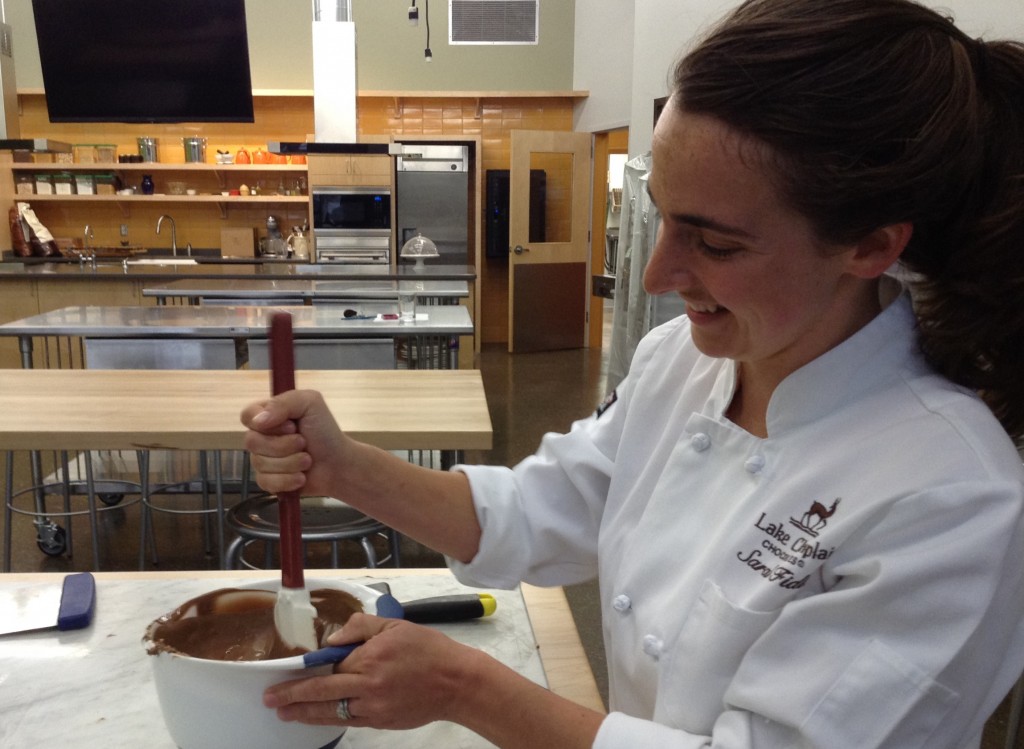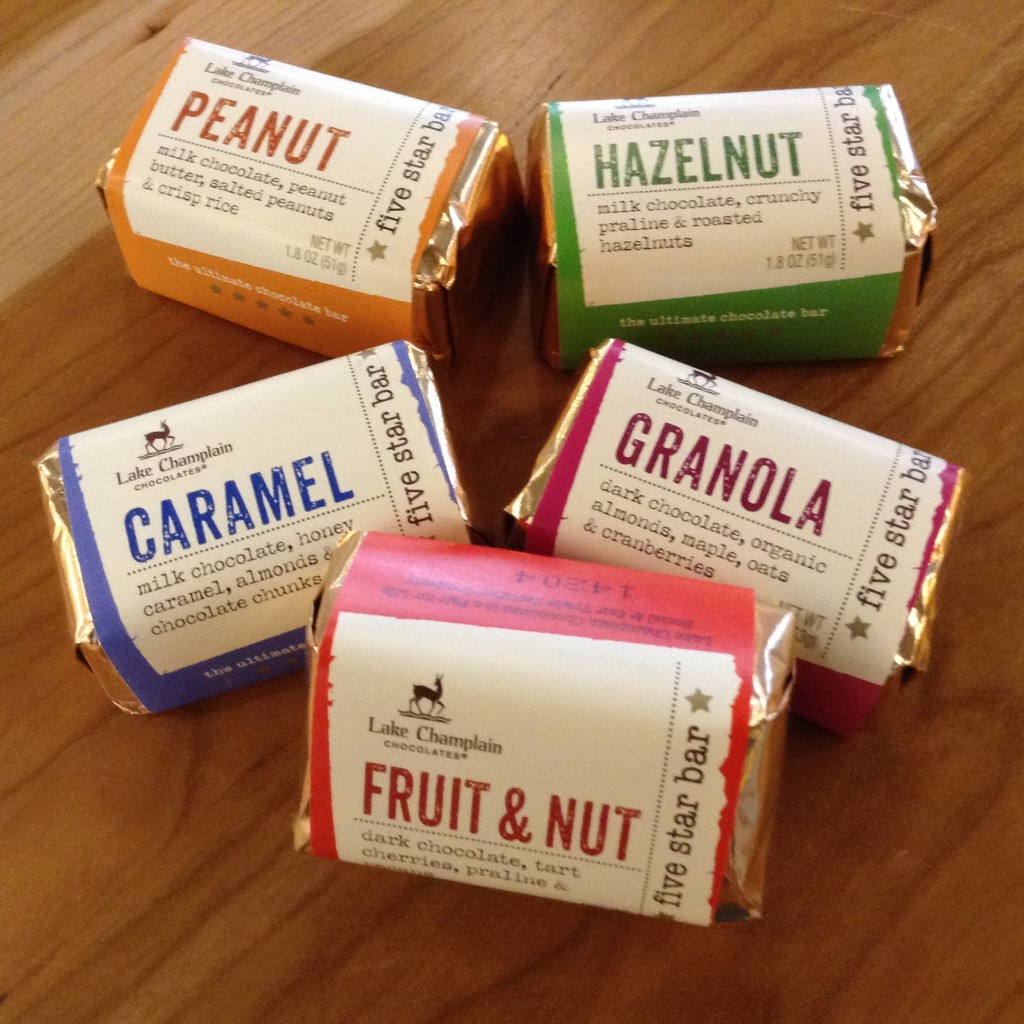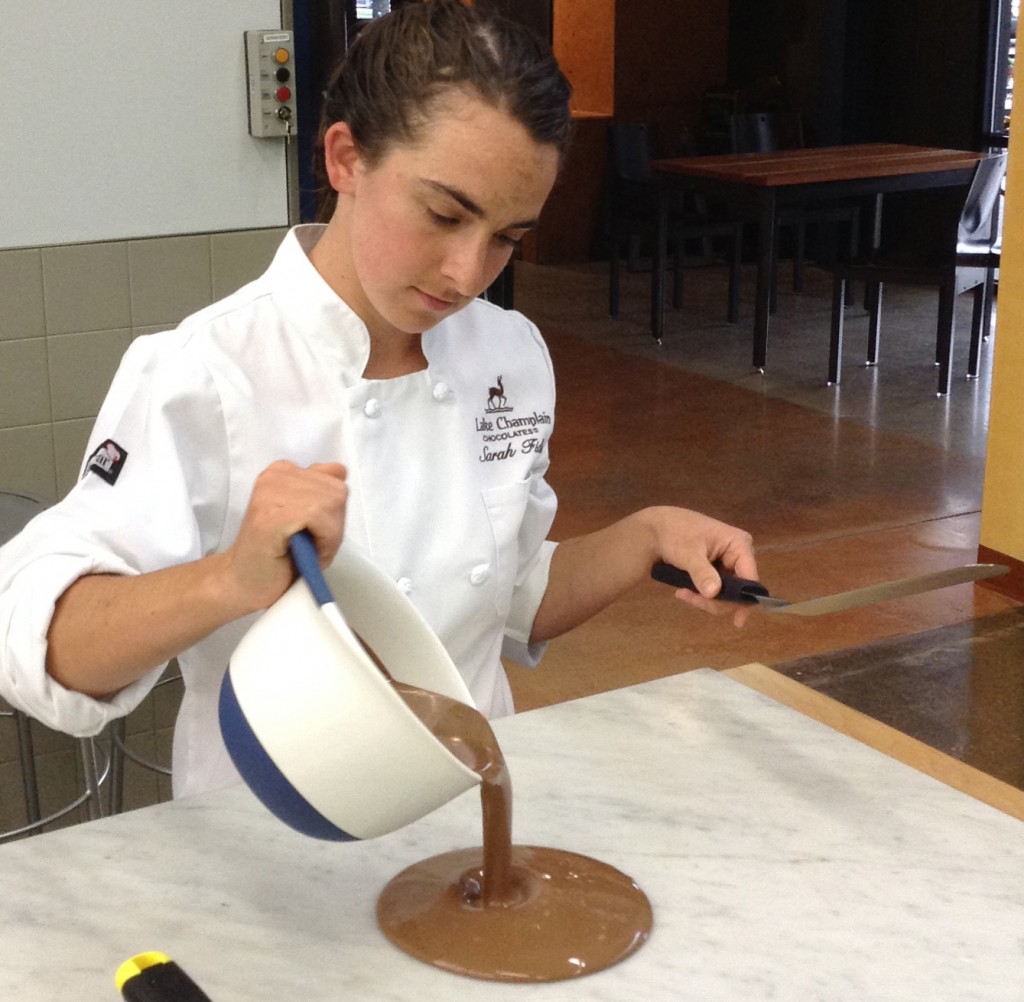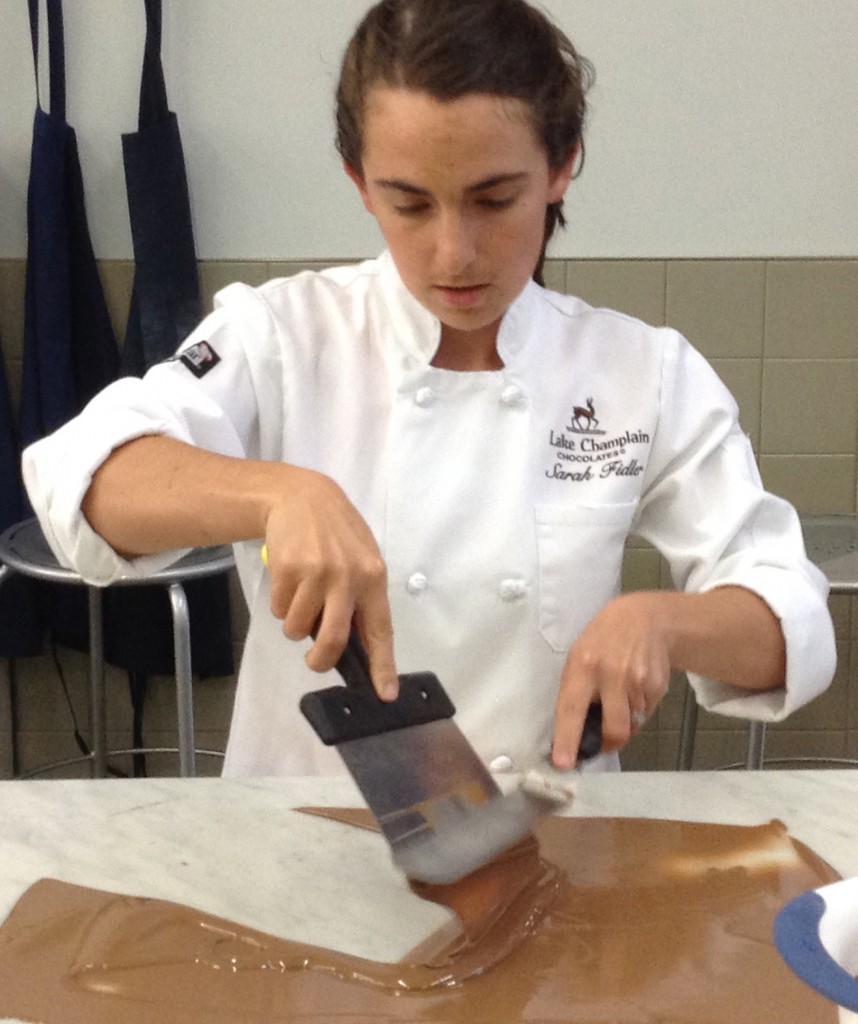During Sarah Fidler’s semester abroad in Paris during her junior year, she wrote a dissertation on pastries and macarons. She was fascinated by the anthropological side of cooking and baking, the history of why certain foods are made in different places, and how family tradition dictates the use of specific ingredients. Studying the role of petit fours on the French table was very different from what she was learning in her dietetics classes in the UVM Department of Nutrition and Food Sciences. Little did she know that her studies in France had planted a seed for her career.
Five years later, Sarah is Research and Development Specialist at Lake Champlain Chocolates in Burlington, VT. Before you have time to wonder if this means she gets to sample her creations, the answer is yes: “I eat a lot of chocolate at work.”

Sarah didn’t plan on a confectionery career. She started at UVM in a pre-med track, then switched to a Dietetics major in Junior year, thinking she wanted to be a Registered Dietitian. When she didn’t land an internship in her senior year, she had no idea what she was going to do next. Two weeks after her graduation in May 2010, she attended her cousin’s graduation from the Culinary Institute of America in Hyde Park, NY. Suddenly, she knew that should be her next step.
As she had no formal kitchen experience, she spent her summer after graduation volunteering at a bakery in Rochester, NY, where she learned the basics of working in a production kitchen. That fall, she worked in a café as a barista and at a restaurant both as a pastry chef and in the front of the house. Her classes at CIA started the following January.
By September of 2012, she had completed her program, including an internship in the pastry kitchen of the Ritz Carlton in Washington, DC. She and her partner (now her husband) remembered fondly Sarah’s time as a student at UVM, and decided to focus their job search on Burlington. Sarah started at LCC in a retail position in their Pine Street store. After 2 months, they realized what a great asset she was to the company, and created the R&D position she now holds.
Sarah’s work requires patience and a lot of trial and error, which most culinary jobs cannot accommodate. While some people thrive in high stress kitchen environments, Sarah knows she does her best work when she is working towards long-term goals. Sarah says she expects failure 70% of the time. “In order to be innovative, you have to be okay with different ideas not working. That’s kind of the fun of it.” It takes an average of 12-18 months to bring a project from concept to the shelf, but by the time it’s there, they’ve already worked out all the kinks.
 Since January, Sarah and her colleagues have been innovating new flavors for LCC’s Five Star Bars, the company’s bestselling product line nationwide. After some handmade batch trials, the team had to consider production cost, availability of ingredients, and whether production will scale up (Sarah had been making the early batches six bars at a time). After many trials, they landed on 3 viable options. A few weeks ago, they brought in a few dozen customers to give feedback on the products. Now, Sarah is testing the shelf life of the new bars, which involves tasting them every 20 days and recording what she notices. If all continues to go well, she expects the new product to be on the shelf as early as March 2015.
Since January, Sarah and her colleagues have been innovating new flavors for LCC’s Five Star Bars, the company’s bestselling product line nationwide. After some handmade batch trials, the team had to consider production cost, availability of ingredients, and whether production will scale up (Sarah had been making the early batches six bars at a time). After many trials, they landed on 3 viable options. A few weeks ago, they brought in a few dozen customers to give feedback on the products. Now, Sarah is testing the shelf life of the new bars, which involves tasting them every 20 days and recording what she notices. If all continues to go well, she expects the new product to be on the shelf as early as March 2015.
In addition to developing new products, Sarah’s work includes maintaining and improving on current products, creating nutritionals for products, educating other parts of the company on initiatives and products, and consulting on recipes with the kitchen staff at the South End Kitchen, LCC’s sister restaurant on Pine Street. She has also worked with Blue Bandana Chocolate Maker, LCC’s microbatch, direct trade, bean-to-bar brand.
Sarah’s position is not one she even knew existed in culinary school, and she’s glad she found it. Few culinary jobs offer a chance to work on long-term projects, a 9-5 weekday work schedule, and benefits. Not to mention, few let you have your hands in chocolate all day long.

Tempered Chocolate: Table Top Method
As a chocolatier, Sarah is a practiced in the art of tempering, a process that gives chocolate a hard, glossy surface. Did you know you can temper chocolate at home? Here’s how:
Equipment
Marble slab or other smooth surface
Thermometer that reads temperatures between 80-130°F
Heating pad (for maintaining temperature while working)
Spatula and/or scraper
Step 1: Break block chocolate into small pieces or use pistoles; this enables the chocolate to melt more easily, with less chance of scorching.
Step 2: Melt chocolate over low heat (preferably using a double boiler), stirring constantly. When it has completely melted, remove from heat.
 Step 3: Pour 1/3 of chocolate onto smooth surface and work with a spatula to spread out and scrape together. Continue spreading and scraping the chocolate over the smooth surface until it cools to 82-84°F. When it is thick with a dull finish, the chocolate is “seeded.”
Step 3: Pour 1/3 of chocolate onto smooth surface and work with a spatula to spread out and scrape together. Continue spreading and scraping the chocolate over the smooth surface until it cools to 82-84°F. When it is thick with a dull finish, the chocolate is “seeded.”
Step 4: Add seeded chocolate to remaining warm chocolate in bowl and stir gently until smooth.
Step 5: Check temperature. It should be 84-91°F. Better yet, check its sheen. If glossy, it is probably ready. Drop a spoonful of chocolate onto waxed paper or plate and cool in refrigerator for 2-3 minutes. Upon removal, if shiny and firm with no streaking, it is ready. If using candy molds, be sure that they are at the same temperature as the tempered chocolate before filling them.
Properly tempered chocolate is glossy in appearance and velvety smooth on the tongue. It will harden, be finely textured, and snap when broken.










